What is Brooding in Poultry Production?
Brooding is defined as the management of chicks from one day old to about 8 weeks of age, and it involves the provision of heat and other necessary care during chicks’ early growing period.
Brooding units are designed to house chicks from one day old until they no longer need supplementary heat (0-8 weeks).
Growing pens are used from the end of the brooding period until the broilers are sold or the pullets moved into permanent laying houses (up to 20 weeks).
Laying pens or cages are used for pullets and hens from the time they start laying until they are culled and sold at the end of the laying period (up to 78 weeks).
Types of Brooding
- Natural brooding
- Artificial brooding
Natural Brooding
The natural method of brooding is used on farms where only a few chickens are raised each year. Depending on her size, a hen will brood 15-20 chickens. The broody hen will provide all the warmth required by the chicks. Before placing the chicks with the hen she would be examined for her good health and free from lice, ticks and other ectoparasites.
Artificial Brooding
Artificial brooding can be defined as the handling of newly born chicks without the aid of hens. It is accomplished by means of a temperature-controlled brooder (foster mother). Artificial brooding has several advantages over the natural method, which are:
- Chicks may be reared at any time of the season.
- Thousands of chicks may be brooded by a single person.
- Sanitary conditions may be controlled.
- The temperature may be regulated.
- Feeding may be undertaken according to the plan.
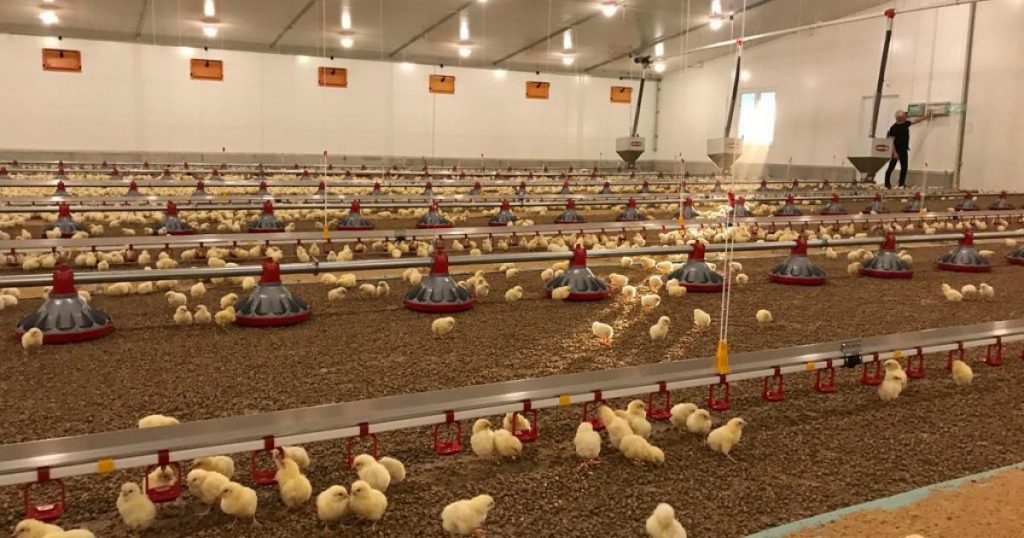
The essentials of a good brooder are a dependable mechanism for controlling temperature and regular supply of fresh air, dryness, adequate light, space, easy disinfection, protection against chick enemies, safety from fire, and economic in construction.
Management of Chicks in the Brooder
- Adjust the temperature as per the requirement of the chicks. In the case of oil heating, see that there is no defect in the stove or lamp. Chicks should not have access to the heated parts of the lamp at any cost.
- Avoid a damp poultry house. You can use a deep litter system.
- Discourage litter eating by the chicks, and scatter mash over egg case flats when the chicks are first taken out of their boxes.
- Provide balanced standard mash.
- Keep provision for the entrance of fresh air.
- Provide clean, fresh water in front of the birds at least twice daily. (Read about the importance of water in poultry farming)
- Clean the brooders including feed hoppers daily.
- Follow a regular vaccination program.
- Avoid overcrowding as this will lead to slow growth and mortality. (Read 10 ways of preventing or reducing a high mortality rate in poultry farming)
- Keep the brooder in such a place that cold wind and rain do not get in.
- Daily inspect the condition of birds and their faces for any sort of abnormality.
- Keep in touch with any veterinarian for help in your time of need.
- It is always advisable to check the fittings, temperature control, feed, and water trough arrangement before shifting the chicks into the brooder.
Also Read: 5 Common Mistakes Some Poultry Farmers Make During Brooding
Brooding Equipment in Poultry
While brooding is an important management practice in poultry production, it is important to know the required brooding equipment. Remember, the purpose of brooding is to raise healthy chicks and provide the required heat (mimicking the mother hen) until they are able to adapt and regulate their body temperature to the ambient temperature.
For brooding to be successful, there is some equipment that must be available in the brooder house/pen. These are the equipment used for brooding:
- Feeders
- Drinkers/waterers
- Brooders
- Brooder guards
- Thermometers
Feeders
Feeders are necessary to provide chicks with food. The best feeders are those that minimize waste while providing enough feed for the chicks. There are many different types of feeders on the market, so it is important to select a feeder that is designed specifically for chicks. There are feed trays and flip-top feeders for this purpose.
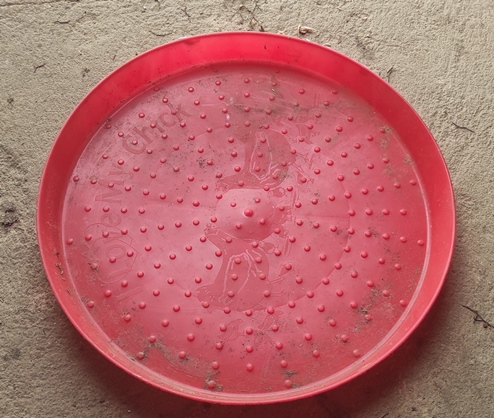
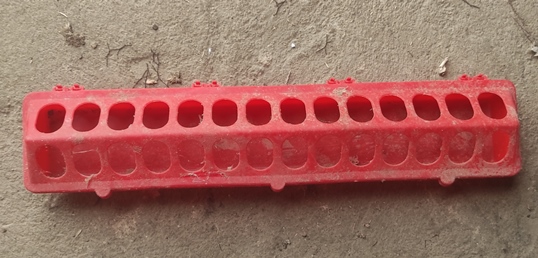
Drinkers
Drinkers/waterers are necessary to provide chicks with water. Like feeders, there are many different types of drinkers on the market, so it is important to select a drinker that works for chicks and young birds. There are nipple drinkers and fountain drinkers for chicks.
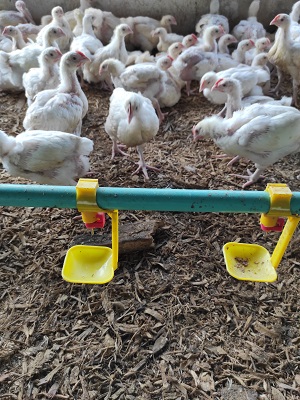
Brooders
Brooders are necessary to provide chicks with the required heat (mimicking the mother hen). To provide the necessary heat some type of brooding device is required.
Types of Brooders
There are different types of brooders. They are:
- Infrared heat lamps
- Gas brooders
- Hover brooders
- Incandescent bulbs
Infrared lamps are an excellent source of heat for brooding small flocks of chicks. The initial cost of equipment is relatively small, and the lamps are excellent for supplying heat to the chicks. The infrared lamp is suspended approximately 18 inches above the litter. One 250-watt bulb is sufficient to brood up to seventy-five chicks. Even though the number of chicks may be small, it is wise to use at least two bulbs in case one fails.
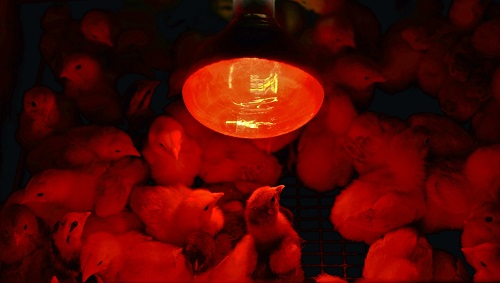
Many small flocks are brooded with homemade brooders utilizing electric light bulbs as the heat source. It is possible to construct simple hovers (canopies) of plywood and canvas, or some similar material, which can be suspended from the ceiling or supported by legs.
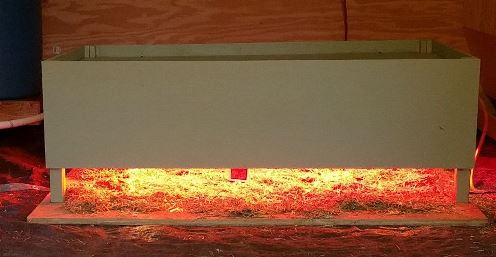
Other brooders manufactured commercially are fired by oil, gas, electricity, wood, or coal. These have a hover to keep the heat down at floor level. Such brooders are excellent for flocks of one hundred chicks or more. Some of them are rated at a capacity in excess of 750 chicks. The initial cost of these units is considerably more than either the infrared lamp or the homemade brooder. Each chick needs a minimum of 7 in2 (17 cm2) of hover space or its equivalent.
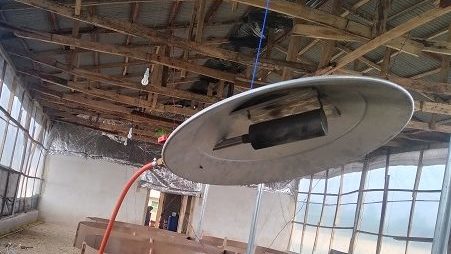
Each type of brooder has certain advantages. The infrared bulb has the advantage of enabling the operator to see the chicks at all times. Where the hover-type brooder is used it is more difficult to observe the chicks. On the other hand, the hover-type brooder is best for cold-weather brooding and is less expensive to operate.
The type of equipment selected will depend, to a certain extent, upon the cost and availability of fuel and the extent to which it is to be used. Whatever brooder stove you use, it should have the capacity to heat adequately and a means for controlling the temperature accurately.
Brooder Guard
The chick or brooder guards help keep chicks within the brooder and help protect them from predators. There are many different types of brooder guards on the market. Most brooder guards are corrugated boards that are used together with brooder guard stands.
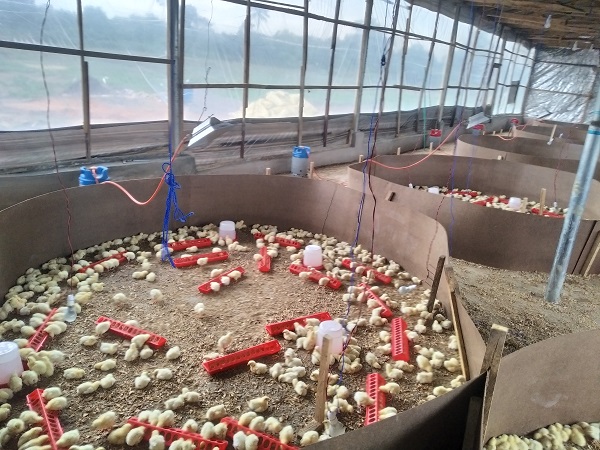
Thermometer
It is important to have a room thermometer inside the brooding pen or house. It is used for monitoring the ambient temperature inside the brooding house. With the help of the room thermometer, you will know if the temperature within the brooding house is cold, moderate or high.
How to Brood Chicks
Getting the chicks off to a good start is very important. Probably no other part of the enterprise deserves more planning and advance preparation than does the starting of baby chicks.
Preparation of the Brooding House
- The brooder house should be cleaned and disinfected or fumigated at least two weeks before the chicks arrive. If this is not done, the chicks may be exposed to certain poultry diseases which can lead to mortality and poor results.
- First sweep or wash down cobwebs, dirt, and dust, then use a good disinfectant. There are a number of good commercial disinfectants available. They should be used according to the manufacturers’ recommendations. Some of them require that the house stand idle for a period of time and be thoroughly aired before the chicks arrive. Failure to observe these precautions may cause the chicks to have severely burned feet and eyes.
- After the brooder house has been cleaned and disinfected, it should be allowed to dry thoroughly before putting in the new litter. When the floor is dry, cover it with 2-4 cm of litter material. The litter material serves to absorb moisture and insulate the floor for the comfort of the birds. Several different materials may be used for litter. Wood shavings are among the most commonly used, whenever available. Other materials include sawdust, or shavings and sawdust, rice hulls, sugar cane, peanut hulls, and ground corn cobs.
- When chicks are extremely hungry upon arrival they may try to eat the litter before learning to eat feed. If you have reason to believe that the chicks have been hatched for two or three days when they arrive, it may be a good idea to put paper over the litter for the first three or four days until they learn to eat. When chicks are received soon after hatching, it is not necessary to do this.
- The electric or gas brooders should be started some hours before the chicks are due to arrive. This will ensure that the equipment is operating properly and is adjusted to the correct temperature.
- Use a chick guard to confine the chicks to the source of heat. The chick guard keeps the chicks confined to a given brooder or heater and also prevents migration and overcrowding of some brooders if more than one brooder is used in the brooding facility. It will also help to prevent drafts on the chicks under the brooder.
- A corrugated cardboard guard, approximately 12 inches high is good for this purpose during cool weather. For warm-weather brooding, the brooding guard may be made of poultry netting. It should form a circle around the brooder about 3 feet. The brooder guard can be extended outward after a few days. It is usually removed on the tenth day or so, depending upon the weather and conditions in the brooder house.
- Fill the feeders and waterers several hours before the chicks arrive. The water will be at room temperature when the chicks arrive and encourage them to drink. The feed trays and water fountains should be spaced uniformly around the brooder and close to the hover. One method frequently used to get chicks to eat, when first put under the hover, is to place a small amount of feed on newspapers.
Chicks instinctively peck at anything at the same level as the surface upon which they are standing. Therefore, they will learn to eat more readily if the feed is provided in this manner for a day or two.
Chicks that are slow to catch on to the fact that feed is in front of them are attracted by the noise made by the others that have found the feed and are pecking on the newspaper. This gets the chicks off to a good start and eating well.
Brooding House, Heat & Litter Management
Brooding temperature is very important. The recommended temperature at the start is 90-95°F (32-35°F). A rule of thumb to remember: Reduce the temperature by 5°F each week until the chicks no longer need heat. It is often stated that the best thermometer, to gauge the most comfortable temperature, is to watch the chicks’ behavior or arrangements (see the picture below).
If the chicks huddle close to the heat source you can be reasonably sure that the operating temperature is too low. If, on the other hand, the birds are located in a circle, way outside the heat source. you should assume that the temperature is too high. During the day the chicks should be evenly distributed around the entire brooding area, with some of the chicks underneath the heat source. Temperature readings should be taken at the outside edge of the brooder at chick level.
One important factor for the successful brooding of chicks is the maintenance of good litter conditions. When litter conditions get out of hand and become too wet, disease problems can result. Wet, dirty litter can harbor many disease organisms that affect poultry.
In the case of pullets, it is desirable to have a certain amount of moisture in the litter (30-35%) to enable the sporulation of oocysts and the subsequent development of immunity to coccidiosis during the growing period. However, excessively wet litter, especially during warm periods, can bring about a clinical case of coccidiosis and result in what we term a coccidiosis break, which requires treatment.
One of the common problems experienced with meat birds such as turkeys and broilers is breast blisters-swellings or external sores on the skin of the breast-which seriously affect the dressed appearance of the carcass. Excessively wet, caked, or dirty litter is frequently blamed for breast blisters. Since perches are not used for broilers or meat birds, the birds must lay down in the litter.
It is important that the litter depth is maintained and that it is kept dry and fluffy enough to cushion the body and avoid all contact with the floor. Furthermore, it is essential that it be reasonably clean to avoid dirtying of the breast feathers, skin irritations, and breast blisters.
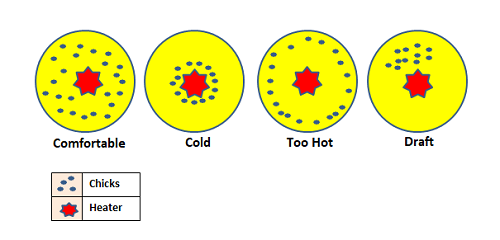
Temperature Requirement for Broilers
| Day | Temperature |
| 1-4 | 32.3-38oC |
| 5-14 | 29.4-26.7oC |
| 21-28 | 26.7-21.2oC |
| 28-56 | 18.3oC |
Adequate ventilation: Ventilation of the brooder house is restricted for the first 1-2 weeks.
For the first four days of brooding, the chicks are supplied feed in shallow feeders like feed trays or thick sheets of paper. Freshwater is supplied every day.
Apart from managing the chicks by regulating temperature, ventilation and providing feed, there are certain routine daily operations that must be followed in the same sequence from morning to evening:
- Remove all dead chicks from the flock to prevent cannibalism and possible infection by pathogenic organisms.
- Fresh feed is supplied and constantly spread by hand.
- Drinkers are taken out and washed thoroughly before being filled with clean cool water.
- There are some special operations that in the short run are stress-inducing but in the long run, confer some overall advantages. These include de-beaking or beak trimming, deworming and vaccination.
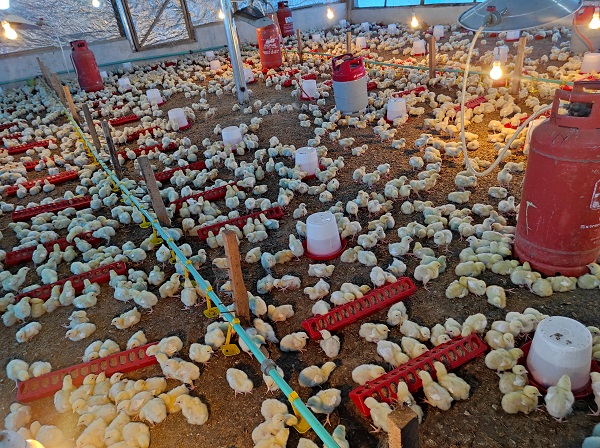
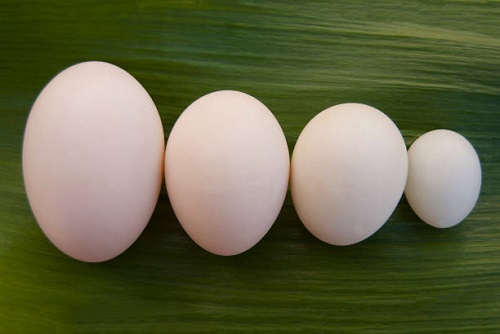
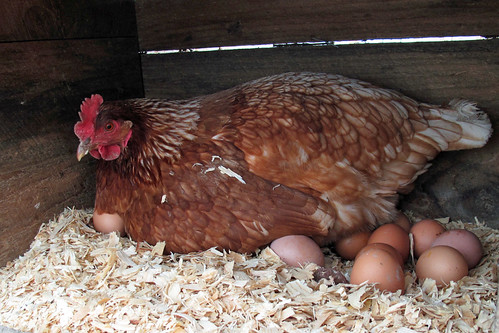

Akinbobola, your articles have helped me immensely. I wouldn’t deny that fact that even while working in US, I have established a farm in Nigeria because I read your articles on importance and potentials of livestock farming. I took up the courage and I have not regretted doing so. I would have sent this privately but I want other readers to know you are actually doing a good job. Keep it up.
Fred
I am also glad that I have impacted people and businesses through this blog. Thank you very much.
Best Regards
Comment:pls how do i get ds recommended rabbit breed for profitable rabbitry.
You can visit the nearest Ministry of Agriculture of your state or a reputable farm that is into rabbit farming.
thank you….i lyk it
I’m glad you like the writeup. Don’t forget to share.
I’m glad you like the writeup. Don’t forget to share.
Akinbobola! Sincerely, you are really doing a good job. I read your articles every day and I have learned a lot about livestock farming from you. God bless you. Please continue to do what you know how to do best. Look forward to meeting you soon.
Thank you! Keep on reading. I’ll surely do my best to help others.
Comment:I really appreciated
Please sir am having problem with net can I have your number so we can talk on phone
I’m so happy to have read this article and
Good to know that you like the article.
Thanks so much for sharing your knowledge with people. This is true love for others. May God richly bless you.
I’m so happy to have read this article, Thanks so much for sharing your knowledge with people.
Thanks You Sir for This Wonderful Enlightment may God bless You
Amen, thank you
Iam starting mine immediately, very brief and precise writeup thank you so much. I wish to get notification everytime on poultry keeping.
This was such an informative article Sir, thank you so much!!!